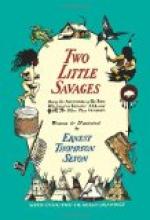Pogue disappeared; folks say he went to the States. The three-fingered tramp never turned up again, and about this time the serious robberies in the region ceased. Three years afterward they learned that two burglars had been shot while escaping from an American penitentiary. One of them was undoubtedly Dick Pogue, and the other was described as a big dark man with three fingers on the right hand.
XXVII
THE RIVAL TRIBE
The winning back of the farm, according to Sanger custom must be celebrated in a “sociable” that took the particular form of a grand house-warming, in which the Raftens, Burnses and Boyles were fully represented, as Char-less was Caleb’s fast friend. The Injun band was very prominent, for Caleb saw that it was entirely owing to the meetings at the camp that the glad event had come about.
Caleb acted as go-between for Char-less Boyle and William Raften, and their feud was forgotten—for the time at least—as they related stories of their early hunting days, to the delight of Yan and the Tribe. There were four other boys there whom Little Beaver met for the first time. They were Wesley Boyle, a dark-skinned, low-browed, active boy of Sam’s age; his brother Peter, about twelve, fair, fat and freckled, and with a marvellous squint; and their cousin Char-less Boyle, Jr., good-natured, giggly, and of spongy character; also Cyrus Digby, a smart city boy, who was visiting “the folks,” and who usually appeared in white cuffs and very high stand-up collar. These boys were greatly interested in the Sanger Indian camp, and one outcome of the meeting at Caleb’s was the formation of another Tribe of Indians, composed of the three Boyle boys and their town friend.
Since most of these were Boyles and the hunting-ground was the Boyles woods about that marshy pond, and especially because they had read of a band of Indians named Boilers or Stoneboilers (Assineboines), they called themselves the “Boilers.” Wesley was the natural leader. He was alert as well as strong, and eager to do things, so made a fine Chief. His hooked nose and black hair and eyes won for him the appropriate name of “Blackhawk.” The city boy being a noisy “show-off,” who did little work, was called “Bluejay” Peter Boyle was “Peetweet,” and Char-less, from his peculiar snickering and showing two large front teeth, was called “Red-squirrel.”
They made their camp as much as possible like that of the Sangers, and adopted their customs; but a deadly rivalry sprang up between them from the first. The Sangers felt that they were old and experienced Woodcrafters. The Boilers thought they knew as much and more, and they outnumbered the Sangers. Active rivalry led to open hostilities. There was a general battle with fists and mud; that proved a draw. Then a duel between leaders was arranged, and Blackhawk won the fight and the Woodpecker’s scalp. The Boilers were wild with enthusiasm. They proposed to take the whole Sanger camp, but in a hand-to-hand fight of both tribes it was another draw. Guy, however, scored a glorious triumph over Char-less and secured his scalp at the moment of victory.




